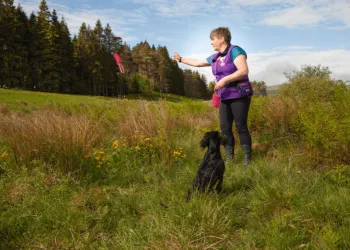
Wondering about your dog's prey drive?
Take the quiz that’s helped thousands of dog owners understand what’s going on with their dog.
One of the most common questions I get is this: Can unmet needs around prey drive develop into reactivity? My answer is a firm yes. In this article, we’ll look at why that is, how to tell if it’s affecting your dog, and what to do about it.
Before we dive in, let’s get clear on two terms: reactivity and prey drive. These are often misunderstood and used inconsistently, so it’s important we’re on the same page.
What Is Reactivity?
Reactivity is a term that gets thrown around a lot but is rarely defined. In general, it refers to a dog who responds strongly or explosively to everyday stimuli—things like lunging or barking at other dogs, people, vehicles, or wildlife. It’s not just a dog who notices something; it’s a dog who can’t help but react, often in ways that feel out of proportion to the situation.
In this blog, when I refer to a reactive dog, I’m talking about a dog who is attempting to create space or control their environment through behaviour most people find difficult. Think: a dog who barks and lunges at another dog across a field, or growls if a stranger approaches when they have a toy.
What Is Prey Drive?
Prey drive is the instinctive urge dogs have to search for, get closer to, chase or bite something they view as prey. Some dogs express it mildly. Others - often those bred for working roles – are much more determined about it.
Important note: Prey drive is not the same as aggression. It is incredibly rare for a dog to view people or other dogs as prey. You might have heard of a concept called predatory drift where dogs are said to suddenly treat a playmate like prey.
Genetics are complex and not as predictable as you might think. Even with careful selective breeding and training, some racing greyhounds don’t reliably chase the lure during races. However, just because genetics are complex don’t mean they are not relevant. There is a reason that greyhounds are racing dogs and Rhodesian ridgebacks are not. While individual variation means that even siblings born in the same litter will be markedly different from each other, it is still useful to consider what a dog may have been bred to do when thinking about prey drive.
This is particularly the case for dogs who are bred for working roles as they are more likely to have the responses to prey that would be expected in their breed.
Most of the jobs dogs have been bred to do use prey drive to an extent. Greyhounds are expected to chase. Hungarian Vizslas are expected to hunt, point and retrieve. Terriers are expected to grab and shake and to be tenacious about getting to prey.
On the whole, it is useful to think that working dogs work at the jobs they do because those jobs fulfil a need that the dogs have rather than because they have been trained to work. For sure, there will be training but without the dog’s internal love of the job, training wouldn’t provide enough motivation on its own.
All of this means that if you have a dog who is a breed or mix of breeds that were carefully selected to respond strongly to prey then it is important to see those responses not as a behaviour problem but instead as your dog expressing something important to them. Even if your dog is a companion breed or mix, they might still have a prey drive. For more on understanding breed tendencies, check out this post on which dogs have a high prey drive.
The Five Freedoms were introduced in the 1990s and have been hugely influential in improving welfare. These days, they are seen as a bare minimum rather than a gold standard for welfare. The freedoms are about avoiding suffering and modern welfare is focused on giving dogs a good life.
Here they are:
1. Freedom from thirst, hunger and malnutrition
2. Freedom from discomfort and exposure
3. Freedom from pain, injury, and disease
4. Freedom from fear and distress
5. Freedom to express normal behaviour.
Most of the dogs I work with easily have the first four covered. But freedom number five? That’s where many high prey drive dogs are let down.
Prey drive is often seen as dangerous. Advice on handling it typically includes:
Preventing it through recall training (read more)
Using punishment or tools like e-collars (my critique here)
Avoiding play that mimics prey (e.g., fetch or flirt poles) – that sort play is sometimes thought to encourage prey drive.
When a core behavioural need like prey drive is consistently blocked, dogs lose that essential fifth freedom. That’s not just unfortunate - it sets the stage for reactivity.
Stress is part of modern life for many dogs. Busy households, fireworks, crowded parks, lack of sleep, or inconsistent routines all chip away at a dog’s capacity to cope.
Most dogs will cope well with those day to day events but high prey drive dogs who are missing that 5th freedom are going to cope less well. Those dogs are much more likely to fall into one or more of the instinctive stress responses: fight, flight, freeze, or fool around.
Fight is the response that matters here. A dog who has reduced welfare and who therefore is not dealing well with the general day to day stressors of life is a dog who is more likely to respond by aggressively chasing a jogger or barking and lunging at a dog they see across the park.
If your dog’s prey drive is being blocked and they’re under chronic stress, reactivity becomes much more likely. The drive doesn’t disappear. It builds.
Frustration is another piece of the puzzle. It is a normal but negative emotional state. Frustration happens whenever an expectation isn’t met or a dog is blocked from something they are highly motivated to do. A high prey drive dog on a lead, behind a fence, or trapped in the house watching squirrels all day? That’s a perfect recipe for frustration.
Frustration often looks like:
Grabbing the lead
Redirected aggression
Barking and/or lunging at unrelated targets
And it builds. One of the ways to build stronger motivation for instinctive behaviour is to deprive dogs of being able to do it. If you’ve ever been told to bring your dog to training class before you feed them rather than after, that’s why. When dogs are hungry, eating is more attractive. Similarly, when dogs are deprived of prey drive outlets, they want to go after prey all the more. I go deeper on this in this blog section on deprivation.
First, get a clearer picture of your dog’s prey drive. Start with this quiz. It’ll help you work out how intense it is, and whether unmet needs might be behind the reactivity.
Then, consider these steps:
Outlet matters. Find appropriate ways to satisfy the drive. That doesn’t mean you have to let your dog harm wildlife - it means spending the time to learn what your dog most wants to do with prey and then offering games based on that.
Train for clarity. Help your dog understand what they cando. That reduces frustration.
Partner with them. Show them you’re working with their instincts, not against them.
You don’t need to solve this in one go. But giving your dog a way to be themselves, safely and clearly, is the best place to start.

Take the quiz that’s helped thousands of dog owners understand what’s going on with their dog.
Prey drive isn’t a problem - it’s part of who your dog is. The issue comes when they can’t meet that need, and it starts spilling over into other behaviours.
If your dog is barking, lunging, or chasing in ways that don’t seem connected to prey, ask yourself: Is there a deeper need going unmet?
When you give your dog an outlet that suits who they are, the whole picture changes. Stress goes down. Frustration eases. Connection grows.
Gompper, M.E., 2021. Adding Nuance to Our Understanding of Dog–Wildlife Interactions and the Need for Management. Integrative and Comparative Biology. 61(1). 93-102. DOI: https://doi.org/10.1093/icb/icab049
Howell, T.J., Bennett, P.C., 2020. Preventing predatory behaviour in greyhounds retired from the racing industry: Expert opinions collected using a survey and interviews. Applied Animal Behaviour Science. 226. 104988. DOI: https://doi.org/10.1016/j.applanim.2020.104988
Howell, T.J., Mongillo, P., Giacomini, G., Marinelli, L., 2018. A survey of undesirable behaviors expressed by ex-racing greyhounds adopted in Italy. Journal of Veterinary Behavior. 27. 15-22. DOI: https://doi.org/10.1016/j.jveb.2018.05.011
McPeake, K.J., Collins, L.M., Zulch, H., Mills, D.S., 2019. The canine frustration questionnaire—development of a new psychometric tool for measuring frustration in domestic dogs (Canis familiaris). Frontiers in veterinary science. 152. DOI: https://doi.org/10.3389/fvets.2019.00152
Mellor, D.J., 2016. Moving beyond the “five freedoms” by updating the “five provisions” and introducing aligned “animal welfare aims”. Animals, 6(10), p.59. DOI: https://doi.org/10.3390/ani6100059
Oxley, J.A., Evans, B., Montrose, V.T., 2017. Prevention of sheep worrying in the UK: Rethinking the approach. Journal of Veterinary Behavior. 19. 61-63. DOI: https://doi.org/10.1016/j.jveb.2017.02.001
Sapolsky, R. M. (2004). Why Zebras Don't Get Ulcers: The Acclaimed Guide to Stress, Stress-Related Diseases, and Coping (Third Edition). United States: Henry Holt and Company.
Siniscalchi, M., d’Ingeo, S., Quaranta, A., 2016. The dog nose “KNOWS” fear: Asymmetric nostril use during sniffing at canine and human emotional stimuli. Behavioural brain research. 304. 34-41. DOI: https://doi.org/10.1016/j.bbr.2016.02.011
Sueda, K.L.C., Malamed, R., 2014. Canine aggression toward people: a guide for practitioners. Veterinary Clinics: Small Animal Practice. 44(3). 599-628. DOI: https://doi.org/10.1016/j.cvsm.2014.01.008
Starling, M., Wilson, B. and McGreevy, P. (2020) ‘Effects of Lure Type on Chase-Related Behaviour in Racing Greyhounds.’ Animals 10(12) p.2262. DOI: https://doi.org/10.3390/ani10122262

Would you like to be in the know?
Join my mailing list, get my monthly newsletter and be kept up to date about special offers via email.

I am the founder of Best Dog Learning and Stuff and a massive prey drive enthusiast. I've lived with high prey drive dogs for over 20 years and I love them. I run the awesome High Prey Drive Club where I help my members learn to have fabulous walks and happy lives with their high prey drive dogs.
I am a published researcher in my field with both my original research and my review of the literature looking at prey drive in dogs being published in the respected journal Applied Animal Behaviour Science.
I peer review for Applied Animal Behaviour Science to help bring quality research into the world.
I am the author of Canine aggression: Rehabilitating an aggressive dog with kindess and compassion.
I want to show you how easy and fun it can be to have a high prey drive dog.
If you'd like help with your dog, I'm ready to help you right now.